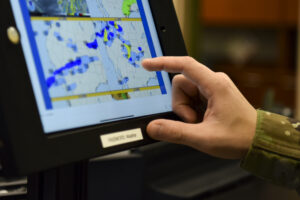Connecting the Dots | The growing market for weather bets
By Jason Rainbow

Improvements in satellite weather data collection and analysis are helping financial investors place better bets on the companies they gamble on.
There’s a “huge world” of weather-related investments and financial instruments that investors are increasingly getting to grips with, according to Rei Goffer, co-founder of meteorological intelligence startup Tomorrow.io.
Weather-affected investments range from outdoor sports companies that lose money when events are washed out to solar power generators that can sell more energy when the weather is good.
While an increasing number of hedge funds are already drawing on the company’s weather analysis tools, Goffer believes further data and modeling advances will open up sizable opportunities for financial investors.
The startup, which used to be called ClimaCell, raised an extra $77 million in March to build its own satellites to improve precipitation forecasts.
Savvy investors are also increasingly using Earth observation imaging satellites to inform financial decisions. Monitoring the number of cars in a supermarket’s parking lot over time, for instance, helps gauge performance before the company announces it.
Using weather forecasts is essentially a shift from snapshots of how the world was or is now to what it will be. Predicting the future, in other words, for profit.
Commodity traders are one of the most important targets for new weather analytics businesses, says Tom Yunck, founder of GeoOptics that is looking to expand its operational fleet of three satellites to improve measurements.
“If [commodity traders] can know a couple weeks in advance what the weather is like that will affect commodity futures and large sums of money can be made or lost with or without that kind of knowledge,” Yunck says.
“So they’re keenly interested in that kind of information. How will the weather over the next couple of weeks affect prices on things that we have to bet on today?”
It has taken quite some time for investors to awaken to this potential, Yunck adds, and “many of them are still asleep.”
Part of the reason why is because the weather industry remains very far from producing 100% reliable forecasts weeks or even days in advance. Even with perfect models and data, it’s impossible to predict further out than 14 days as the butterfly effect takes hold.
However, any edge a trader can get over the competition in the days before that is advantageous in a market that juggles probabilities every day.
As a rough rule of thumb, weather forecasts improve by about a day every decade, although some say this progress has recently slowed to every 15 years because of climate change and other complexities.
“Weather modeling and prediction continues to improve year-over-year, and we have already seen strong, weather future-related markets take hold,” says Adrián Cuadra, program director for the GOES-R weather satellites at Lockheed Martin.
“The most prevalent example of this is the billion-dollar private weather market that leverages weather data to make decisions in commercial markets like risk management, airlines and agriculture.”
There isn’t a lot of publicity about how investors are actually using weather forecasts on a more granular level today — those that are successful are naturally cagey about it.
In 2018, Bloomberg reported that Chicago-based hedge fund Citadel hired the founder and about 20 traders and analysts from weather-driven investment firm Cumulus, which had shut down operations. Citadel declined to comment.
But while improving weather forecasts will increasingly help hedge funds make a quick buck, the biggest financial impact will come from enabling companies to avoid surprises that hit their bottom lines.
Peter Platzer, CEO of space data and analytics provider Spire Global, points to long-standing research showing about a third of global GDP is impacted by surprise weather events.
While there’s nothing companies can do to avoid much of that, Platzer says studies show around 10% of it — some $3 trillion economic losses on a global basis every year — could in principle be reduced with better weather forecasts.
“The money that financial services make out of more accurate weather prediction is going to be completely dwarfed by the economic benefits that industry will reap,” he says.
As far as emerging markets go, Lockheed Martin’s Cuadra says it’s worth noting that the fidelity of weather modeling and the increasing need for Earth observations feed one another.
“Models are getting better and better, and this actually drives the need for more observations of the Earth system to feed data into those models,” he says.
“In turn, increased observations drive the need to improve models that can take advantage of those observations. This cyclical relationship is where we could see emerging markets.”
May 26, 2021 at 06:57PM
via SpaceNews read more...

Post a Comment